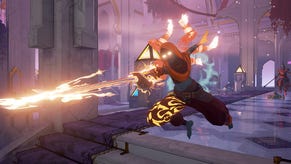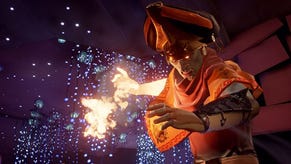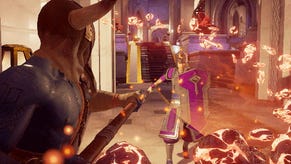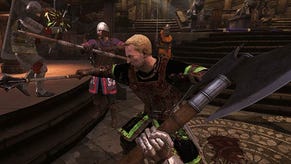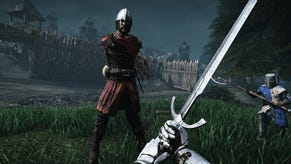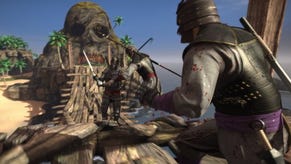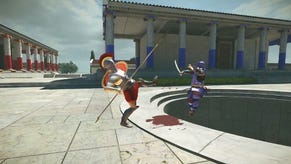Wot I Think: Chivalry - Medieval Warfare
Rampant
Chivalry: Medieval Warfare is an extremely violent pageant of limb-lopping, a first-person deathmatch game as bloody as any I’ve ever played. For several days now I have carved my way through the ranks of my enemies and now, upon this scroll, I do declare that this is Wot I Think(eth).
Given the choice, I’ll generally opt for the more personal affray of medieval warfare over the aloof and distant death-dealing of the modern variety. It’s at least partly for the same reasons I prefer manoeuvring a crate around the skies of World War The First rather than joining the jet-set, able to destroy what they cannot yet see. Chivalry’s knights, with their devastating attacks and cumbersome armour, are the Super Hadleys of their time, best used to deliver their devastating payload when accompanied by lighter, more agile men-at-arms.
Ideally, spectating a bout of Chivalric slaughter should entail observing squadrons of men working in harmony, archers providing support, the vanguard forming blockades when enemy forces begin to engage, and the knights unleashed from the bay of pikes that bristle around them to punch through final defences.
That’s not what happens though. Battlefields quickly become bottlenecks of coagulated blood as streams of respawning hopefuls rush back to their objective, which is either an actual trigger on the map or simply the soft flesh of every opponent. Rarely have I seen such carnage. A couple of days ago, I accidentally joined a 32 player match in the game’s arena, a small space with spike-laden pillars and flame-belching traps. I might as well have just spent ten minutes watching a documentary about extreme surgical procedures.
By the end, the score didn’t matter and the nuance of the excellent combat had fallen to the wayside. I spawned, I died. Sometimes I hacked off a man’s arms and watched him cough up his ghost in the dirt in between spawning and dying, but, through the mist of blood and desperation, it was often hard to tell which of the severed meat-parcels belonged to me and which belonged to some other poor soul.
Although the tone is more Monty Python than Geoffrey of Monmouth, with the training voiced by a merry gang of light-hearted dialects, the animations and gurgling chokes of the dying are suitably grim. Heads have a tendency to roll, with a wonderfully macabre touch whereby the first-person view remains within the severed neck-cork. Often have I seen my own body falling to its knees, the hands instinctively attempting to stem the flow of life’s own liquor.
The thrusts, parries, chops and feints that lead to death or victory are the qualities by which Chivalry shall live or die, and, happily, Torn Banner have crafted a hugely convincing first-person melee combat system. Simplicity and tight collision detection are the key, with the right mouse button blocking, the left slashing, and the mousewheel performing a long-reaching stab (up) or devastating overhead hack (down).
There are three melee classes of varying strength and mobility to choose from, as well as pesky archers. Each comes with a choice of equipment, including auxiliary weapons such as throwing knives. Carrying a shield allows for permanent blocking, although all damage is directional and accurately tracked, so defences must actually be ‘aimed’ to connect with weapons. Weapons will catch on scenery and will also slice through allies as easily as enemies. Friendly filleting is exceedingly common, most often, in my experience, when somebody is trying to save me from overwhelming odds. A knight rushes in on my surrounded man-at-arms, swings his word in a mighty arc and then picks through the offal to say sorry to my still-blinking face.
None of that would be worth a damn if the feedback wasn’t as effective as it is. Heft a double-handed axe into an archer’s unprotected midriff and it’ll knock the blighter aside and he probably won’t be getting up again. If that same archer reacts quickly enough to whip out a dagger and stab at the axe-wielding menace bearing down on him, he’ll most likely see his blade glance off the armour. All of this does mean that lag can be ruinous and for the game to have any longevity, it needs not only a strong playerbase but widely spread servers. I’ve been fine, apart from some initial but easily corrected bugginess that left me with blank server lists, but it’s impossible to predict how well the opening week’s business will be retained.
Aiming for areas that are padded rather than plated, or better still completely exposed, really does work. I’ve rarely played as an archer because they are often the unhappy snipers of the age and deserve to be sliced in twain – and yet I have very much enjoyed firing an arrow into an onrushing foe’s neck, finding a gap in his protective plate and killing him instantly. In an organised group, archers are more useful, providing support and wearing enemies down, but in the madness that usually exists on a server, they are more a nuisance than a threat.
At first I thought that the lack of tactical considerations that seems to be the norm would be a hindrance to my enjoyment. Even with a strong combat system, an endless procession of combat without context would mostly likely become tedious sooner rather than later. There are only six maps, one being the arena and another taking the form of an immediately recognisable capture the flag setup. The remaining four have team objectives and tie into the fictional world’s ongoing conflict.
Objectives generally involve one group needing to be in a specific place, whether to kill the peasants that live there or to push the corpse wagon that is there, while the other team must stop them. They do add structure to the maps, which are superbly realised and surprisingly atmospheric, and those that progress through multiple stages make for half hour matches that can hang in the balance from phase to phase. My favourite, Stoneshill, ends with one of the defending team being crowned king, instantly becoming tough as nails but marked as an objective and hunted by every member of the opposing team. He can cower in his castle, where his allies respawn, or, as happened in one very odd match I played, he can leap around on the battlements shouting challenges at everyone below.
The small number of maps is less important than it would be if this were a shooty game, where positioning and architecture are far more significant. Archers might care to be on higher ground and there are environmental toys, such as burning oil and ballistae, but on the whole the scenery is a path leading to the fight, and once in combat, the only area that matters is the small square of land on which you will live or die. I do find myself playing the team objectives more than any other game type (team deathmatch, king of the hill, free-for-all – choices dependent on the map), the targets and choice of attacking or defending adding just the right amount of variety and context, but Chivalry’s structure does not impose itself, for better or worse.
You load the game, you scan a server list, you kill and you die. I actually found the lack of anything else except maps, servers and combat quite liberating. There are weapon and equipment unlocks earned by playing the four classes over time, but the base weapons are more than capable of getting the job done and nobody ever seems particularly advantaged. Or at least not simply by their equipment – a knight against a man-at-arms must be careful, timing his slow swings well as the nimble opponent dodges and blocks, cutting and stabbing. It’s a skill-based game, a melee Unreal Tournament, and in that sense it feels old-fashioned like a damn good cocktail rather than a limited throwback.
Apart from training, there are only bots for the singleplayer. They’re not horrible but they’re not very good. It’s amusing to see a group rush for the same point at the same time, sometimes becoming trapped in a clump. They resolve the situation as men of the sword should; by kicking each other out of the way and bellowing. I did spend some time learning the maps and objectives surrounded by them and found that playing one on one in the arena against the computer is a decent way to learn the intricacies of each weapon, but this is a game to be played with people, whether strangers or friends.
I’m in no doubt that a team that communicates and plans will be far more successful than the chaotic marauders that populate most servers, but, importantly, being one of those chaotic marauders is a blast. The combat is all about timing, whether raising an axe overhead and knowing precisely when to charge so that its blade falls through an enemy’s shoulder, or timing a parry, a feint or a dodge just before the moment of impact. Because of the precision of both impact and control, even when the rest of your team are running around like headless chickens, it’s possible to take pleasure in the personal combats that are only ever a few seconds away.
Perhaps Chivalry doesn’t have the scope of War of the Roses, lacking mounts and any real sort of avatar progression and customisation, but they are both games about hitting men with swords, and Chivalry does that particular thing with more grace, gore and accuracy. Not historical accuracy, because this is almost as silly as Die By the Sword, but accuracy of control and intent. Slight though it is in content, Chivalry has the crown because, when the blood begins to flow, all that matters is the tiny parcel of land, a sword's swing in breadth, on which men live and die.
Chivalry is available now, direct from the developers, for $24.99, or $74.99 for a four pack. You can also find it at various digital stores, including Steam and Gamersgate.






